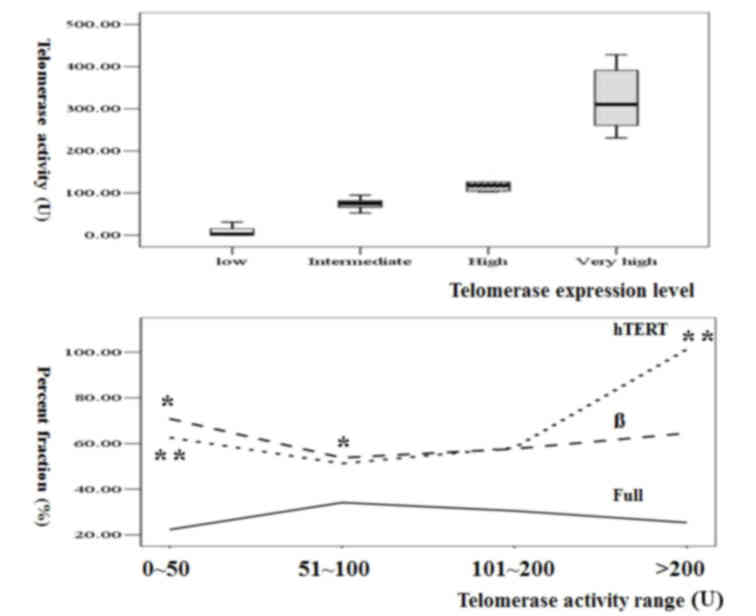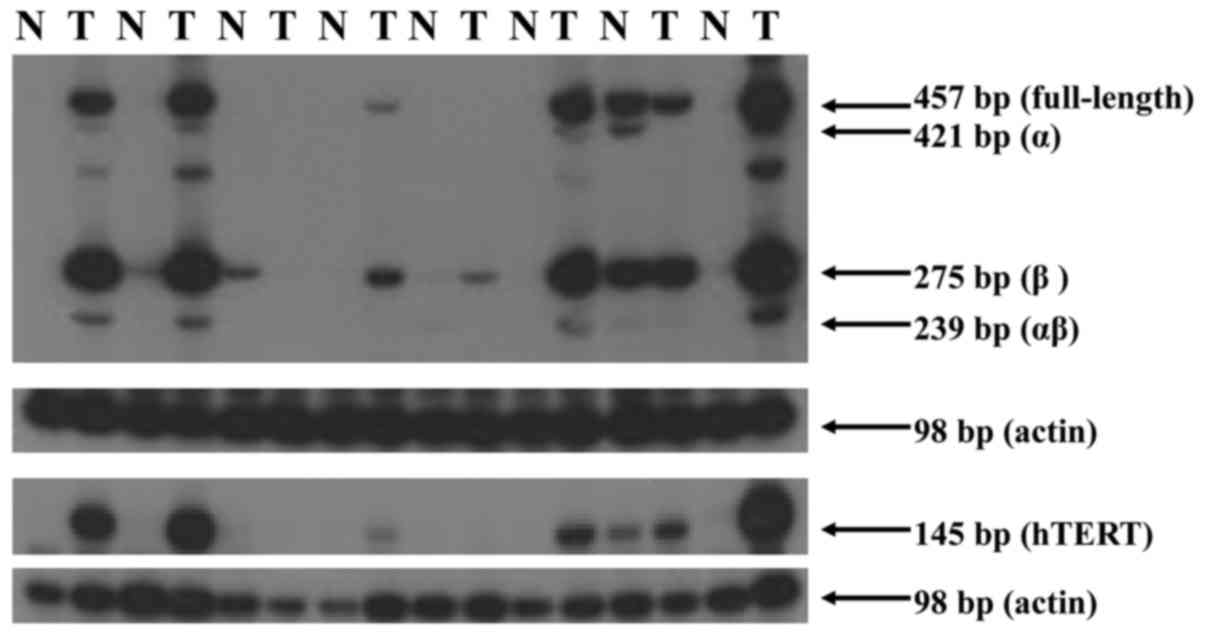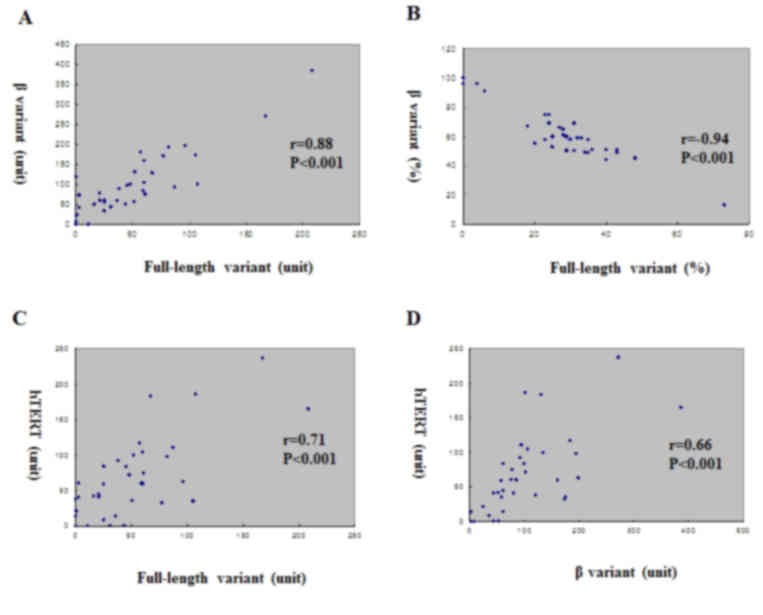|
1
|
Liu K, Schoonmaker MM, Levine BL, June CH,
Hodes RJ and Weng NP: Constitutive and regulated expression of
telomerase reverse transcriptase (hTERT) in human lymphocytes. Proc
Natl Acad Sci USA. 96:pp. 5147–5152. 1999; View Article : Google Scholar : PubMed/NCBI
|
|
2
|
Ramakrishnan S, Eppenberger U, Mueller H,
Shinkai Y and Narayanan R: Expression profile of the putative
catalytic subunit of the telomerase gene. Cancer Res. 58:622–625.
1998.PubMed/NCBI
|
|
3
|
Krams M, Claviez A, Heidorn K, Krupp G,
Parwaresch R, Harms D and Rudolph P: Regulation of telomerase
activity by alternate splicing of human telomerase reverse
transcriptase mRNA in a subset of neuroblastomas. Am J Pathol.
159:1925–1932. 2001. View Article : Google Scholar : PubMed/NCBI
|
|
4
|
Villa R, Porta CD, Folini M, Daidone MG
and Zaffaroni N: Possible regulation of telomerase activity by
transcription and alternatively splicing of telomerase reverse
transcriptase in human melanoma. J Invest Dermatol. 116:867–873.
2001. View Article : Google Scholar : PubMed/NCBI
|
|
5
|
Killian A, Bowtell DD, Abud HE, Hime GR,
Venter DJ, Keese PK, Duncan EL, Reddel RR and Jefferson RA:
Isolation of a candidate human telomerase catalytic subunit gene,
which reveals complex splicing patterns in different cell types.
Hum Mo Genet. 6:2011–2019. 1997. View Article : Google Scholar
|
|
6
|
Ulaner GA, Hu JF, Vu TH, Giudice LC and
Hoffman AR: Telomerase activity in human development is regulated
by human telomerase reverse transcriptase (hTERT) transcription and
by alternate splicing of hTERT transcripts. Cancer Res. 58:1–4172.
1998.PubMed/NCBI
|
|
7
|
Ulaner GA, Hu JF, Vu TH, Giudice LC and
Hoffman AR: Tissue-specific alternate splicing of human telomerase
reverse transcriptase (hTERT) influences telomere lengths during
human development. Int J Cancer. 91:644–649. 2001. View Article : Google Scholar : PubMed/NCBI
|
|
8
|
Brenner CA, Wolny YM, Adler RR and Cohen
J: Alternative splicing of the telomerase catalytic subunit in
human oocytes and embryos. Mol Human Repro. 5:845–850. 1999.
View Article : Google Scholar
|
|
9
|
Colgin LM, Wilkinso C, Englezou A, Kilian
A, Robinson MO and Reddel RR: The hTERTalpha splice variant is a
dominant negative inhibitor of telomerase activity. Neoplasia.
2:426–432. 2000. View Article : Google Scholar : PubMed/NCBI
|
|
10
|
Weinrich SL, Pruzan R, Ma L, Ouellette M,
Tesmer VM, Holt SE, Bodnar AG, Lichtsteiner S, Kim NW, Trager JB,
et al: Reconstitution of human telomerase with the template RNA
component hTR and the catalytic protein subunit hTRT. Nat Genet.
17:498–502. 1997. View Article : Google Scholar : PubMed/NCBI
|
|
11
|
Rha SY, Jeung HC, Yang WI, Kim JJ, Oh TJ,
An SW and Chung HC: Alteration of hTERT full-length variant
expression level showed different gene expression profiles and
genomic copy number changes in breast cancer. Oncol Rep.
15:749–755. 2006.PubMed/NCBI
|
|
12
|
Yi X, Shay JW and Wright WE: Quantitation
of telomerase components and hTERT mRNA splicing patterns in
immortal human cells. Nucleic Acid Res. 29:4818–4825. 2001.
View Article : Google Scholar : PubMed/NCBI
|
|
13
|
Hara T, Noma T, Yamashiro Y, Naito K and
Nakazawa A: Quantitative analysis of telomerae activity and
telomerase reverse transcriptase expression in renal cell
carcinoma. Urol Res. 29:1–6. 2001. View Article : Google Scholar : PubMed/NCBI
|
|
14
|
Zaffaroni N, Porta C Della, Villa R, Botti
C, Buglioni S, Mottolese M and Daidone M Grazia: Transcription and
alternative splicing of telomerase reverse transcriptase in benign
and malignant breast tumours and in adjacent mammary glandular
tissues: Implications for telomerase activity. J Pathol. 198:37–46.
2002. View Article : Google Scholar : PubMed/NCBI
|
|
15
|
Yokoyama Y, Wan X, Takahashi Y, Shinohara
A and Tamaya T: Alternatively spliced variant deleting exon 7 and 8
of the human telomerase reverse transcriptase gene is dominantly
expressed in the uterus. Mol Hum Repro. 7:853–857. 2001. View Article : Google Scholar
|
|
16
|
Wright WE, Shay JW and Piatyszek MA:
Modifications of a telomeric repeat amplification protocol (TRAP)
result in increased reliability, linearity and sensitivity. Nucleic
Acid Res. 23:3794–3795. 1995. View Article : Google Scholar : PubMed/NCBI
|
|
17
|
Park KH, Rha SY, Kim CH, Kim TS, Yoo NC,
Kim JH, Roh JK, Noh SH, Min JS, Lee KS, et al: Telomerase activity
and telomere lengths in various cell lines: Changes of telomerase
activity can be another method for chemosensitivity evaluation. Int
J Oncol. 13:489–495. 1998.PubMed/NCBI
|
|
18
|
Rha SY, Park KH, Kim TS, Yoo NC, Yang WI,
Roh JK, Min JS, Lee KS, Kim BS, Choi JH, et al: Changes of
telomerase and telomere lengths in paired normal and cancer tissues
of breast. Int J Oncol. 15:839–845. 1999.PubMed/NCBI
|
|
19
|
Yeo M, Rha SY, Jeung HC, Hu SX, Yang SH,
Kim YS, An SW and Chung HC: Attenuation of telomerase activity by
hammerhead ribozyme targeting human telomerase RNA induces growth
retardation and apoptosis in human breast tumor cells. Int J
Cancer. 114:484–489. 2005. View Article : Google Scholar : PubMed/NCBI
|
|
20
|
Sobin LH, Gospodarowicz MK and Wittekind
C: TNM classification of malignant tumors. 7th. New York: Wiley;
pp. 200921
|
|
21
|
Lincz LF, Mudge LM, Scorgie FE, Sakoff JA,
Hamilton CS and Seldon M: Quantitation of hTERT splice variants in
melanoma by SYBR green real-time polymerase chain reaction
indicates a negative regulatory role for the beta deletion variant.
Neoplasia. 10:1131–1137. 2008. View Article : Google Scholar : PubMed/NCBI
|
|
22
|
Jalink M, Ge Z, Liu C, Björkholm M, Gruber
A and Xu D: Human normal T lymphocutes and lymphoid cell lines do
express alternative splicing variants of human telomerase reverse
transcriptase (hTERT) mRNA. Biochem Biophys Res Commun.
353:999–1003. 2007. View Article : Google Scholar : PubMed/NCBI
|
|
23
|
Shervington A and Patel A: Differential
hTERT mRNA processing between young and older glioma patients. FEBS
Lett. 582:1707–1710. 2008. View Article : Google Scholar : PubMed/NCBI
|
|
24
|
Chebel A, Rouault JP, Urbanowicz I,
Baseggio L, Chien WW, Salles G and Ffrench W: Transcriptional
activation of HTERT, the human telomerase reverse transcriptase, by
nuclear factor of activated T cells. J Biol Chem. 284:35725–35734.
2009. View Article : Google Scholar : PubMed/NCBI
|
|
25
|
Liu C, Fang X, Ge Z, Jalink M, Kyo S,
Björkholm M, Gruber A, Sjöberg J and Xu D: The telomerase reverse
transcriptase (hTERT) gene is a direct target of the histone
methyltransferase SMYD3. Cancer Res. 67:2626–2631. 2007. View Article : Google Scholar : PubMed/NCBI
|
|
26
|
Kang X, Chen W, Kim RH, Kang MK and Park
NH: Regulation of the hTERT promoter activity by MSH2, the hnRNPs K
and D, and GRHL2 in human oral squamous cell carcinoma cells.
Oncogene. 28:565–574. 2009. View Article : Google Scholar : PubMed/NCBI
|
|
27
|
Briatore F, Barrera G, Pizzimenti S,
Toaldo C, Casa CD, Laurora S, Pettazzoni P, Dianzani MU and Ferrero
D: Increase of telomerase activity and hTERT expression in
myelodysplastic syndromes. Cancer Biol and Ther. 8:883–889. 2009.
View Article : Google Scholar
|
|
28
|
Moriai M, Tsuji N, Kobayashi D,
Kuribayashi K and Watanabe N: Down-regulation of hTERT expression
plays an important role in 15-deoxy-Delta 12,14-prostaglandin
J2-indiced apoptosis in cancer cells. Int J Oncol. 34:1363–1372.
2009.PubMed/NCBI
|
|
29
|
Noureini SK and Wink M: Transcriptional
down regulation of hTERT and senescence induction in HepG2 cells by
chelidonine. World J Gastroenterol. 15:3603–3610. 2009. View Article : Google Scholar : PubMed/NCBI
|
|
30
|
Fu XH, Zhang JS, Zhang N and Zhang YD:
Combination of telomerase antisense oligonucleotides simultaneously
targeting hTR and hTERT produces synergism of inhibition of
telomerase activity and growth in human colon cancer cell line.
World J Gastroenterol. 11:785–790. 2005. View Article : Google Scholar : PubMed/NCBI
|
|
31
|
Oken MM, Creech RH, Tormey DC, Horton J,
Davis TE, McFadden ET and Carbone PP: Toxicity and response
criteria of the Eastern Cooperative Oncology Group. Am J Clin
Oncol. 5:649–655. 1982. View Article : Google Scholar : PubMed/NCBI
|
|
32
|
Astler VB and Coller FA: The prognostic
significance of direct extension of carcinoma of the colon and
rectum. Ann Surg. 139:846–852. 2003. View Article : Google Scholar
|













